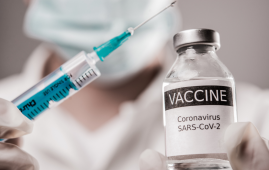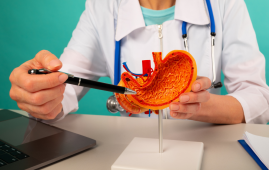

According to a preliminary first-in-human study that will be presented at Digestive Disease Week (DDW) 2023, a procedure that uses controlled electrical pulses to induce changes in the lining of the first part of the small intestine could allow patients with type 2 diabetes to stop taking insulin while still maintaining glycemic control. “The potential for controlling diabetes with a single endoscopy process is spectacular,” said Celine Busch, the study’s lead researcher, and Ph.D. candidate in gastroenterology at Amsterdam University Medical Center. “One of the biggest advantages of this treatment is that a single outpatient endoscopic procedure provides glycemic control, a potential improvement over drug treatment, which depends on patients taking their medication day in, day out.”
Diabetes affects more than 37 million Americans, with type 2 diabetes accounting for more than 90% of cases. Type 2 diabetes is most common in those over the age of 45, although it is also becoming more common in children, teenagers, and young adults. Glucose-lowering medicine can be costly, and insulin injections have a number of negative effects, including the danger of low blood sugar and weight gain.
In this preliminary trial, 14 patients were subjected to an endoscopy in which alternating electrical pulses were administered to the duodenum, a section of the small intestinal lining right below the stomach. Patients were discharged the same day after the hour-long treatment and placed on a calorie-controlled liquid diet for two weeks. Patients then began taking semaglutide, a diabetes medicine, titrating up to 1 mg a week. Semaglutide on its own sometimes allows patients with type 2 diabetes to quit taking insulin, but only in about 20% of cases, Busch said. In this study, 12 of 14 patients, or 86%, maintained good glycemic control without insulin for a year, suggesting the improvement is related to the procedure and not just to the semaglutide. Authors are beginning work on a double-blind randomized controlled trial to test these results.
“While drug therapy is ‘disease-controlling,’ it only reduces high blood sugar as long as the patient continues taking the medication,” said Jacques Bergman, M.D., Ph.D., principal investigator on the study and professor of gastrointestinal endoscopy at Amsterdam University Medical Center. “This one procedure is ‘disease-modifying’ in that it reverses the body’s resistance to its own insulin, the root cause of type-2 diabetes.”
Previous researchers investigated the impact of ablation, which uses heat to modify the lining of the small intestine, after observing that patients who underwent gastric bypass had improved insulin control immediately after the surgery, even before any weight loss could occur, indicating that bypassing this portion of the small intestine plays a role in type 2 diabetes glycemic control.
According to Busch, researchers speculated that persistent exposure to a high-sugar, high-calorie diet causes an unknown change in this part of the small intestine, making the body resistant to its own insulin. Researchers believe that regenerating the tissue in this section of the gut increases the body’s ability to respond to its own insulin, particularly in type 2 diabetes patients whose bodies still respond to insulin.
Dr. Busch will present data from the study, “Re-cellularization via electroporation therapy (ReCET) combined with GLP1ra to replace insulin therapy in patients with type 2 diabetes: Six-month results of the EMINENT study,” abstract 1272, on Tuesday, May 9, at 4:22 p.m. CDT.
more recommended stories
 Brain Chemistry & Political Attitudes: Neural Switch Theory
Brain Chemistry & Political Attitudes: Neural Switch TheoryIn summary, a recent study uses.
 Immunosuppression Driver Found in Glioblastoma
Immunosuppression Driver Found in GlioblastomaFilippo Veglia, Ph.D., an assistant professor.
 Early Brain Development: Gene Control Atlas Unveiled
Early Brain Development: Gene Control Atlas UnveiledAn atlas of the brain’s early.
 PLS Riskier in ABO Mismatched Lung Transplants
PLS Riskier in ABO Mismatched Lung TransplantsPassenger lymphocyte syndrome (PLS) is a.
 Lysosomal Function in Parkinson’s Disease Risk
Lysosomal Function in Parkinson’s Disease RiskThe genetic traits that affect the.
 Omega-6 Fatty Acid Role in Bipolar Disorder
Omega-6 Fatty Acid Role in Bipolar DisorderHigher concentrations of arachidonic acid, an.
 Transplant Drug Shows Promise in Slowing Alzheimer’s in Seizure Patients
Transplant Drug Shows Promise in Slowing Alzheimer’s in Seizure PatientsProtein imbalances, which heighten the excitability.
 Fentanyl Inhalation: Brain Damage Risks
Fentanyl Inhalation: Brain Damage RisksAfter treating a middle-aged man who.
 Enhanced Immune Response in New COVID-19 Vaccines
Enhanced Immune Response in New COVID-19 VaccinesAn improved vaccination offers an enhanced.
 Bioresorbable Wireless Sensor for Early Stomach Leakage Detection
Bioresorbable Wireless Sensor for Early Stomach Leakage DetectionIn a recent publication in Scientific.

Leave a Comment